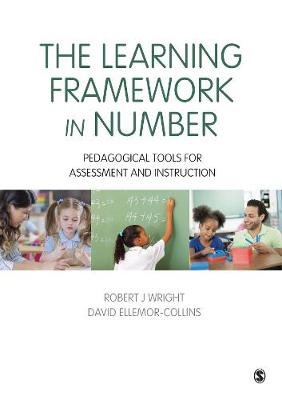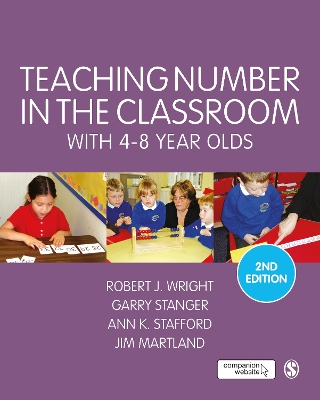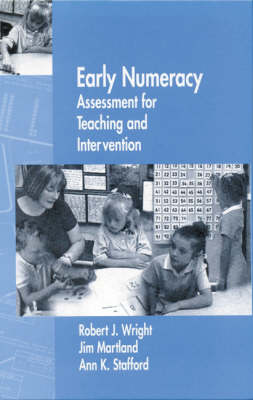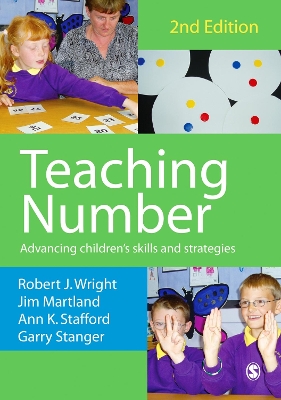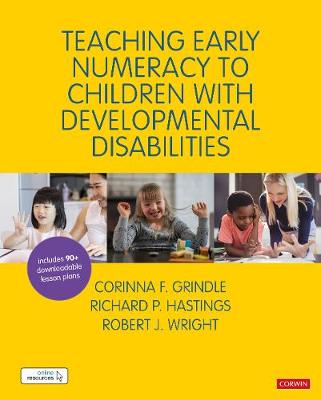Math Recovery
6 total works
The Learning Framework in Number
by Robert J. Wright and David Ellemor-Collins
- Nine carefully designed schedules of assessment tasks
- Nine models of learning progressions
- Ten teaching maps that guide the instructional progressions across key topics
The book offers guidance on innovative video-based assessment, and an overview of principles of intervention instruction, giving you an integrated resource for supporting the children you teach.
The Learning Framework in Number will be a useful guide for all primary and elementary school classroom teachers and assistants, and specialist teachers, including experienced Mathematics Recovery (R) instructors. The book will also be of significant interest to teacher educators and researchers.
Teaching Number in the Classroom with 4-8 Year Olds
by Robert J. Wright, Garry Stanger, Ann K. Stafford, and James Martland
Bring the principles and practice of the acclaimed Mathematics Recovery Programme to whole-class teaching!
WHY INVEST IN THE NEW EDITION?
- In full-colour with a revised layout for clearer navigation
- More up-to-date tasks, activities and real classroom examples
- Learning trajectories for guiding instruction and tracking progress on key topics
- Extra resources online on the companion website
Part of the best-selling Maths Recovery series, this practical, step-by-step guide to classroom instruction takes an inquiry-based approach to assess children's knowledge and build on this to develop a firm foundation of understanding and confidence in mathematics. Topics covered range from beginning number and early counting strategies to multi-digit addition and subtraction right through to multiplication and division.
An invaluable resource for use on pre-service teacher training courses and for all primary classroom teachers and assistants, including experienced Mathematics Recovery instructors, as well as learning support personnel, primary mathematics advisors, numeracy consultants and educational psychologists.
WHAT EXTRAS ARE ON THE COMPANION WEBSITE?
- Downloadable extra chapter resources like print-out grids, worksheets, cards and much more
- A Facilitator's Guide that can be used either individually or in group study to help you get the most out of the material
- In-class video demonstrations to clearly show how the instructional activities in the book are used in the classroom
- Webinar discussing the key points in the book and how it supports your teaching
"Research informs practice in this easy to access resource. Each chapter gives educators practical, bite-sized assessments, linked to a host of activities that helps them target teaching and develop the firm foundations which are so vital for confident and competent mathematicians." - Jill Piotrowski, Numeracy Consultant, Wigan Local Authority, UK
"'The Classroom Instructional Framework in Early Number is research-based and provides a roadmap of not only the what, but the when and the how to teach all aspects of early number." - Vicki Nally, Mathematics Consultant at Catholic Education Office, Melbourne
"The structured approach offers a wealth of rich and easily implemented classroom-based activities that work - thousands of teachers in Ireland attest to this!" - Noreen O'Loughlin, Director Maths Recovery and Maths Education Lecturer, Mary Immaculate College, Limerick, Ireland
Developing Number Knowledge
by MR Robert J J Wright, David Ellemor-Collins, and Pamela D D Tabor
Drawing on extensive programs of research, curriculum development, and teacher development, the book offers a coherent, up-to-date approach emphasising computational fluency and the progressive development of students' mathematical sophistication. The book is organized in key domains of number instruction, including structuring numbers 1 to 20, knowledge of number words and numerals, conceptual place value, mental computation, written computation methods, fractions, and early algebraic reasoning.
Features include:
" fine-grained progressions of instruction within each domain;
" detailed descriptions of students' strategies and difficulties;
" assessment tasks with notes on students' responses;
" classroom-ready instructional activities;
" an accompanying CD with extensive instructional resources.
This book is designed for classroom and intervention teachers, special education teachers and classroom assistants. The book is an invaluable resource for mathematics advisors and coaches, learning support staff, numeracy consultants, curriculum developers, teacher educators and researchers.
`An ambitious book about an ambitious project. It offers a detailed description of some aspects of Mathematics Recovery' - Times Educational Supplement
This book offers schools an assessment instrument to identify and deal with children who under-achieve in early numeracy. It will enable teachers, trainers and numeracy consultants to learn a distinctive and comprehensive approach to assessing and teaching arithmetical strategies.
Based on extensive long-term research, the authors' Mathematics Recovery Programme has been successfully applied by teachers in Australia (as Count Me in Too), the United Kingdom and the United States, in specialist interventions and general classroom settings.
The book focuses on the Learning Framework in Number (LFIN) which guides the assessment and teaching. This consists of eleven key aspects of early number development, including: identifying the stages of early arithmetical learning; strategies for adding and subtracting; knowledge of number word sequences and numerals; ability to reason in terms of tens and ones; and developing strategies for multiplication and division.
Early Numeracy complements the National Numeracy Strategy and other international initiatives, by providing a deeper, highly practical focus on the mathematical attainment and identified needs of young children.
Teaching Number
by Robert J. Wright, James Martland, Ann K. Stafford, and Garry Stanger
Each chapter has clearly defined teaching procedures which show how to take the children onto the next more sophisticated stage. The teaching procedures are organized into key teaching topics, and each includes:
- a clearly defined purpose
- detailed instructions, activities, learning tasks and reinforcing games
- lists of responses which children may make
- application in whole class, small group and individualised settings
- a link to the Learning Framework in Number (see Early Numeracy- second edition, 2005)
- how the guiding principles for teaching can be used to allow teachers to evaluate and reflect upon their practice
Primary practitioners in Australia, the United States, the United Kingdom and Canada have tested the teaching procedures which can be used in conjunction with each country's numeracy strategy.
Primary teachers, especially of the early years, mathematics co-ordinators, heads of school, mathematics advisers, special educationalists, learning support personnel, teacher assistants, lecturers in initial teacher training and educational psychologists will all find this book invaluable.
Teaching Early Numeracy to Children with Developmental Disabilities
by Corinna Grindle, Richard Hastings, and Robert J. Wright
This practical guide for teaching numeracy to children with a developmental disability is based on core concepts from the landmark Mathematics Recovery® text Teaching Number (aka ‘the green book’) that have been adapted for children with developmental disabilities.
It sets out key principles of teaching and learning underpinning an evidence-based teaching approach and provides clear guidance on how educators can plan and implement a structured teaching program so that every child can be given a positive experience in learning numeracy and achieve significant outcomes, maximizing their potential.
The book is supported by a comprehensive set of online resources for use in the classroom, including 90+ lesson plans carefully tailored to provide sequenced learning experiences for children and school students who may need them most...
